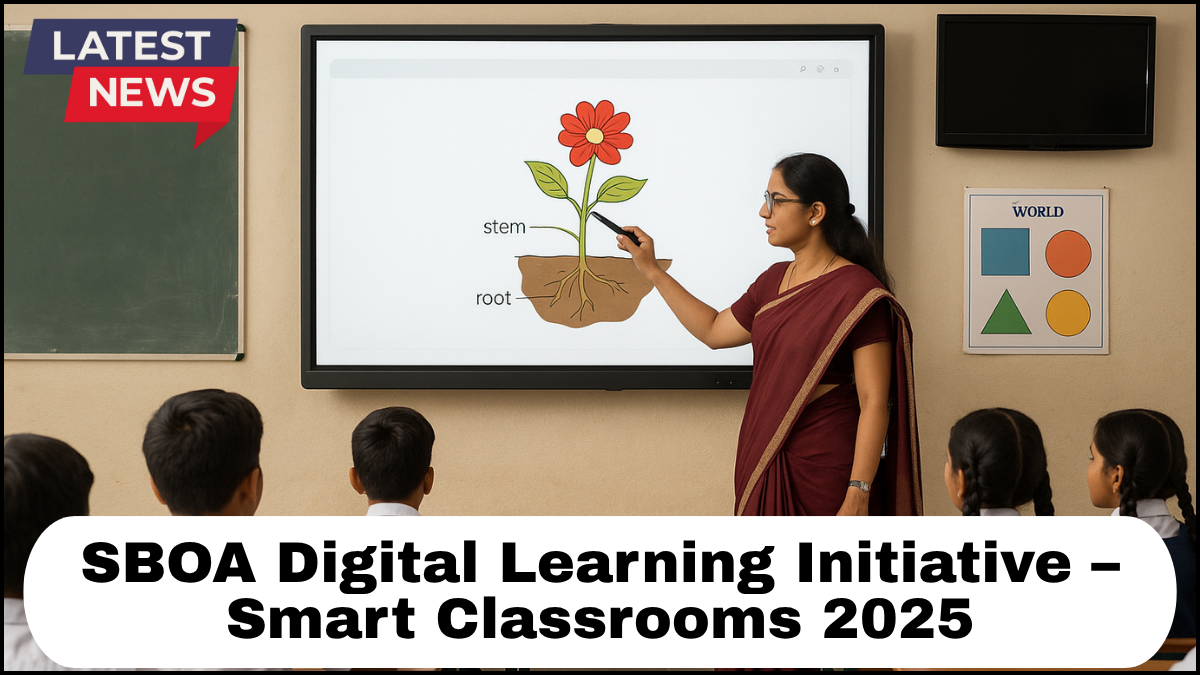As the world of education pivots towards immersive, tech-integrated learning environments, the SBOA Digital Learning Initiative stands at the forefront of this transformation. With the ambitious Smart Classrooms 2025 vision, SBOA (State Bank of India Officers’ Association) Educational Institutions are redefining classroom learning by seamlessly blending technology, pedagogy, and student engagement. This initiative isn’t just about digitizing the classroom—it’s about reshaping how students learn, think, and grow in a digitally empowered future.

What is the SBOA Digital Learning Initiative?
The Digital Learning Initiative by SBOA is a comprehensive educational reform plan aimed at embedding advanced digital tools and smart learning practices into the academic ecosystem of SBOA schools across India. It’s not just an upgrade—it’s a complete re-engineering of traditional education models to make learning more interactive, accessible, and future-ready.
At the core of this initiative is the commitment to:
-
Integrate smart classroom technologies into all levels of education
-
Provide teachers with advanced training in digital pedagogy
-
Ensure equitable access to digital resources for all students
-
Foster critical thinking, creativity, and collaboration through tech-enabled methods
The Vision of Smart Classrooms 2025
The Smart Classrooms 2025 vision aims to equip every classroom under the SBOA umbrella with intelligent teaching and learning systems. These include interactive digital boards, real-time content sharing, AI-assisted learning analytics, and cloud-based student performance tracking.
Key components of the smart classrooms include:
-
Interactive Digital Boards: Replacing traditional blackboards, these boards allow teachers to project multimedia content, annotate in real time, and enhance student interaction with visual simulations and concept maps.
-
AI-Based Learning Platforms: Intelligent software tools help in tailoring learning content to each student’s pace and preferences, enabling personalized learning paths.
-
Cloud-Connected Devices: Students and teachers can access coursework, assignments, and notes from anywhere, creating a seamless bridge between home and school learning.
-
Virtual Reality (VR) & Augmented Reality (AR): These immersive technologies help explain complex subjects like biology, chemistry, and history with life-like simulations and 3D visualizations.
Empowering Teachers for the Digital Era
Technology is only as effective as the educators who wield it. That’s why the SBOA Digital Learning Initiative includes extensive training and certification programs for teachers to master new digital teaching tools.
Workshops and webinars are regularly organized to:
-
Enhance digital content creation skills
-
Guide teachers in using analytics to track and boost student performance
-
Promote innovative teaching methods, such as flipped classrooms and gamified learning
Bridging the Digital Divide
One of the standout strengths of this initiative is its emphasis on inclusivity. SBOA is committed to minimizing the digital gap by:
-
Providing tablets or laptops to underprivileged students
-
Ensuring reliable internet access in rural and semi-urban campuses
-
Creating offline-compatible learning modules for areas with connectivity challenges
This approach ensures that digital learning isn’t a privilege but a right for every student under the SBOA system.
Results So Far and What’s Ahead
Early implementation across pilot schools has shown promising results. Student engagement levels are up by over 40%, and academic outcomes have improved due to more dynamic content delivery and real-time feedback mechanisms.
By 2025, the goal is to have 100% of SBOA classrooms operating as smart classrooms, backed by a robust digital learning framework that continuously evolves with emerging educational technologies.
FAQs
What is the SBOA Digital Learning Initiative?
It’s a strategic program by SBOA institutions aimed at modernizing education through the integration of digital tools and smart classroom technologies.
How are smart classrooms different from traditional classrooms?
Smart classrooms use digital boards, AI-driven learning platforms, and cloud-based tools to make education more interactive, personalized, and accessible.
Are teachers trained to use smart classroom technologies?
Yes. SBOA provides continuous professional development and digital training sessions to help teachers effectively use smart classroom tools.
How does the initiative help students in remote or rural areas?
SBOA ensures digital inclusivity by offering devices, internet support, and offline-compatible learning modules for students in areas with limited digital access.
When will all SBOA schools have smart classrooms?
The target is to fully implement smart classrooms across all SBOA schools by the end of 2025.
click here to learn more